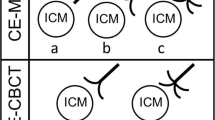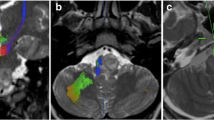Abstract
Purpose
The aim of this retrospective study is to investigate the value of the susceptibility-weighted imaging (SWI) sequence compared to gradient echo (GRE) in the detection and follow-up of cavernous malformations in patients who underwent whole-brain irradiation as part of their medulloblastoma treatment.
Methods
We retrospectively examined MRI studies of 28 subjects (16 males, 12 females) who received whole-brain irradiation as part of their treatment. Ages at irradiation ranged from 2 to 38 years. All patients were periodically followed up with MR imaging (ranging from 9 to 336 months). Two neuroradiologists reviewed studies of the same patients, comparing the number of suspected cavernomas detected on GRE and SWI sequences performed at different times (median time between studies, 10 months).
Results
Hypointense lesions were detected in 24 subjects on SWI sequences and in 19 subjects on GRE sequences. More lesions were seen on SWI than on GRE (p = 0.006). Four patients had no detectable lesions. The minimal period from irradiation to first lesion detection was 14 months. Cavernomas larger than 3 mm were detected in 14 subjects by both GRE and SWI. None of the subjects had symptoms related to cavernomas.
Conclusions
The sensitivity of SWI in the detection of hypointense lesions in patients after whole-brain irradiation is significantly higher than that of the GRE sequence. It appears that almost all subjects eventually develop small hypointense lesions after radiotherapy, and some of them progress to cavernous malformations. The clinical significance of the increased sensitivity of SWI in this group of patients is not entirely certain.



Similar content being viewed by others
Abbreviations
- WBRT:
-
Whole-brain radiation therapy
- CM:
-
Cavernous malformation
- PNET:
-
Primitive neuroectodermal tumor
References
American Brain Tumor Association. Types of tumor. http://www.abta.org/brain-tumor-information/types-of-tumors/medulloblastoma.html. Accessed 12 Jan 2018
Ciricillo SF, Cogen PH, Edwards MS (1994) Pediatric cryptic vascular malformations: presentation, diagnosis and treatment. Pediatr Neurosurg 20:137–147
Peters S, Pahl R, Claviez A, Jansen O (2013) Detection of irreversible changes in susceptibility-weighted images after whole-brain irradiation of children. Neuroradiology 55:853–859
Lew SM, Morgan JN, Psaty E, Lefton DR, Allen JC, Abbott R (2006) Cumulative incidence of radiation-induced cavernomas in long-term survivors of medulloblastoma. Neurosurgery 104:103–107
Yamasaki F, Takayasu T, Nosaka R, Kenjo M, Akiyama Y, Tominaga A, Sugiyama K, Kobayashi M, Kurisu K (2015) The postirradiation incidence of cavernous angioma is higher in patients with childhood pineoblastoma or primitive neuroectodermal tumors than medulloblastoma. Childs Nerv Syst 31:901–907
Baumgartner JE, Ater JL, Ha CS, Kuttesch JF, Leeds NE, Fuller GN, Wilson RJ (2003) Pathologically proven cavernous angiomas of the brain following radiation therapy for pediatric brain tumors. Pediatr Neurosurg 39:201–207
de Souza JM, Domingues RC, Cruz LC Jr, Domingues FS, Iasbeck T, Gasparetto EL (2008) Susceptibility-weighted imaging for the evaluation of patients with familial cerebral cavernous malformations: a comparison with t2-weighted fast spin-echo and gradient-echo sequences. AJNR Am J Neuroradiol 29:154–158
Bulut HT, Sarica MA, Baykan AH (2014) The value of susceptibility weighted magnetic resonance imaging in evaluation of patients with familial cerebral cavernous angioma. Clin Exp Med Int J 72:5296–5302
Zabramski JM, Wascher TM, Spetzler RF, Johnson B, Golfinos J, Drayer BP, Brown B, Rigamonti D, Brown G (1994) The natural history of familial cavernous malformations: results of an ongoing study. Neurosurgery 80:422–432
Di Giannatale A, Morana G, Rossi A et al (2014) Natural history of cavernous malformations in children with brain tumors treated with radiotherapy and chemotherapy. J Neuro-Oncol 117:311–320
Sparacia G, Speciale C, Banco A, Bencivinni F, Midiri M (2016) Accuracy of SWI sequences compared to T2*-weighted gradient echo sequences in the detection of cerebral cavernous malformations in the familial form. Neuroradiol J 29:326–335
Cheng AL, Batool S, McCreary CR, Lauzon ML, Frayne R, Goyal M, Smith EE (2013) Susceptibility-weighted imaging is more reliable than T2*-weighted gradient-recalled echo MRI for detecting microbleeds. Stroke 44:2782–2786
Guo LF, Wang G, Zhu XY, Liu C, Cui L (2013) Comparison of ESWAN, SWI-SPGR, and 2D T2*-weighted GRE sequence for depicting cerebral microbleeds. Clin Neuroradiol 23:121–127
Jain R, Robertson PL, Gandhi D, Gujar SK, Muraszko KM, Gebarski S (2005) Radiation-induced cavernomas of the brain. AJNR Am J Neuroradiology 26:1158–1162
Cha YJ, Nahm JH, Ko JE, Shin HJ, Chang J-H, Cho NH (2015) Pathological evaluation of radiation-induced vascular lesions of the brain: distinct from de novo cavernous hemangioma. Yonsei Med J 56:1714–1720
Pagenstecher A, Stahl S, Sure U, Felbor U (2009) A two-hit mechanism causes cerebral cavernous malformations: complete inactivation of CCM1, CCM2 or CCM3 in affected endothelial cells. Hum Mol Genet 18:911–918
Haasdijk RA, Cheng C, Maat-Kievit AJ, Duckers HJ (2012) Cerebral cavernous malformations: from molecular pathogenesis to genetic counselling and clinical management. Eur J Hum Genet 20:134–140
Cutsforth-Gregory JK, Lanzino G, Link MJ, Brown RD Jr, Flemming KD (2015) Characterization of radiation-induced cavernous malformations and comparison with a nonradiation cavernous malformation cohort. J Neurosurg 122:1214–1222
Mouchtouris N, Chalouhi N, Chitale A, Starke RM, Tjoumakaris SI, Rosenwasser RH, Jabbour PM (2015) Management of cerebral cavernous malformations: from diagnosis to treatment. ScientificWorldJournal 2015:808314
Author information
Authors and Affiliations
Corresponding author
Ethics declarations
Funding
No funding was received for this study.
Conflict of interest
The authors declare that they have no conflict of interest.
Ethical approval
All procedures performed in the studies involving human participants were in accordance with the ethical standards of the institutional and/or national research committee and with the 1964 Helsinki Declaration and its later amendments or comparable ethical standards. For this type of study formal consent is not required.
Informed consent
For this type of retrospective study formal consent is not required.
Rights and permissions
About this article
Cite this article
Khasminsky, V., Yalon, M., Greenberg, G. et al. Detection of cavernous malformations after whole-brain radiotherapy in primitive neuroectodermal tumor patients—comparing susceptibility-weighted imaging and T2 gradient-echo sequences. Neuroradiology 60, 913–919 (2018). https://doi.org/10.1007/s00234-018-2055-8
Received:
Accepted:
Published:
Issue Date:
DOI: https://doi.org/10.1007/s00234-018-2055-8




